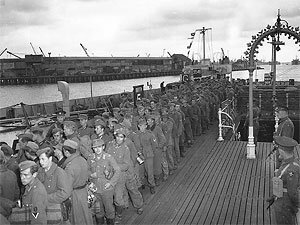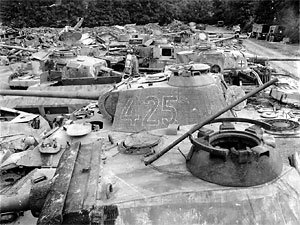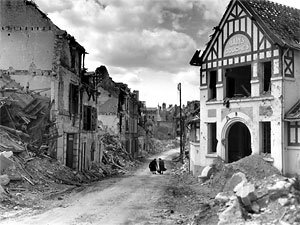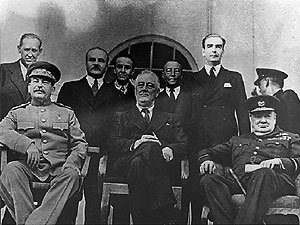The battle
An assesment for the Normandy campaign
German prospect
 End of June 1944 - German prisoners arrive in Great Britain.
End of June 1944 - German prisoners arrive in Great Britain.
When planning invasion of Europe, allied headquarters bet on a costly landing but a fast progression in the next steps. Confrontation to reality shoved the optimism of these expectations. Dominated by all the superiorities of their opponents - aviation, artillery, intelligence, quantity, logistics – the armies of the Third Reich resisted two months and three weeks, inflicting to their adversaries painful losses and setbacks - Omaha, Villers-Bocage, hill 112, Saint-Lo, Verrières crest, Maczuga - are as many tragic names synonymous for the allies of blood, sweat and tears. However, the extent of the German defeat, humanly and materially, is impressive. It is not possible to take of it measurement without observing that one week after their exit of Normandy, the allied units were already in Belgium, and in some places at the doors of the Reich.
It is the assessment of the human losses which seems the easiest to establish. The battle of Normandy was a haemorrhage for the German army. The despaired attempts to hold the frontline at all cost meant for all german units imposing losses. The Germans were to leave in Normandy 200.000 killed or missing, and 250.000 prisoners. The soldiers engaged in Normandy were of a good level. By their experience, their motivation and their team spirit, one can say that they presented slightly more value than their allied counterpart. The loss of this “median” class of soldiers turned out to be catastrophic for the German army. From now on, its forces would rest more and more on a elitist handle of fanaticized Waffen-SS, the core being composed of a mass of impromptu troops – the Volkssturm…
The losses are even more appalling through the list of killed generals. Were killed during the battle of Normandy the German generals:
- Falley (91st ID), in the night of June 6th, meeting American parachutists;
- Dawans, chief of staff of Panzer Gruppe West, on June 10th south of Caen, in an air raid;
- Marcks (84th Korps, “one of the most skilled German Generals”, said Eisenhower), June 12, killed in an attack of Jabos;
- Witt (12th SS-PzD), the 14, in a naval bombardment;
- Hellmich (243e ID), while fighting the US advance on CHerbourg;
- Stegmann (77th ID), on June 18th, while fighting back an attack of the 9th US infantry division on Bricquebec with its division;
- Dollmann, June 28th, of a heart attack (some sources believe in suicide);
- Tychsen (2nd SS-PzD), July 28th, near Gavray, surprised in his Kubelwagen by advanced elements of 2nd US armored division;
- Drabich-Wätchter (326th ID), on August 2nd, killed by a shell close to Caumont;
- Kraiss (352nd ID), mortally wounded in the area of Domfront on August 2nd.
One could also quote Von Kluge, who committed suicide while returning to Germany on August 18th.
 August 1944 - German tanks destroyed in the Dives valley, waiting
August 1944 - German tanks destroyed in the Dives valley, waiting
for scraping. At the end of the battle, tens of thousands of wrecks
strew the Norman fields. © CR Basse-Normandie/NA USA
As regards to prisoners, the Allies captured Von Schlieben, commander of the garrison of Cherbourg, on June 26th; Elfeld, replacing Marcks at the head of the 84th Korps, surrendered to the Poles on August 20th. Menny (84th ID) and Badinski (276th ID) were caught the following day. Eberbach, commander of the 7th Army, was captured on August 31st on Somme river during the pursuit phase.
Wounded Generals were also numerous: Von Schweppenburg, in an air attack on June 9th. Rommel, in the same way, on July 17th. As for Raising, Meyer (12th SS), or Schimpf (3rd FjD), they will be seriously wounded while leaving the Falaise pocket through the lines of the 1st Polish armoured division.
The Norman odyssey also finishes for the Germans by heavy equipment losses. At the end of August, Normandy is strewed with carcasses of all kinds of vehicles and materials. During the struggle, one estimates that 1.500 tanks, 2.000 guns and 20.000 vehicles were destroyed, not to mention hundreds of planes. The assessments usually forget to speak about horse-drawn vehicles. However, those represented in Normandy the very large majority of the transportation means of the infantry units of the Wehrmacht. Deprived of their mobility, these units will be seriously handicapped in their following operations.
In terms of divisions, on the 43 divisions involved in the battle, 25 were completely destroyed. The elite Panzer Lehr had to be dissolved as well as 9th Panzer division and a series of less important units. Rare are the units that managed to escape from Normandy with more than 20% of their initial manpower.
Lastly, the way in which Hitler carried out the battle of Normandy involved with the loss of this battle the loss of the remainder of France. From now on, the retirement of the Germans does not seem to be able to rely on any position or effective line of defence. To the East, the next natural defences are the Lorraine heights, but to the north, the Allies penetrate in a vast plain which runs as far as the Netherlands. Its rivers and channels are maybe able to delay a division or an army Corps, but certainly not to stop the offensive of the two army groups available to the Allies at the beginning of September…
Allied prospect
 1944 - Like so many other cities in Normandy, Falaise has been
1944 - Like so many other cities in Normandy, Falaise has been
completly destroyed and awaits reconstruction… © CR Basse-
Normandie
Overlord plan scheduled liberation of Normandy in less than one month; this turned out to be wrong. Allied forces needed more time to achieve this difficult goal, but final success have been more complete than expected. Indeed, once forced the Normandy door, all France felt into their hands.
Allies lost in the battle over 200.000 men, including 37.000 dead. Contrary to the Germans who did not manage to supplement their manpower and their equipment, the allied losses were systematically replaced, often with better, battle-tested equipment.
Military success was incontestably the result of the political achievement which represented the capacity of the allies to overcome their divergences. It was not always easy thing, taking into account the difficult character of the commanders and the delicate situations which they had to face. Montgomery accepted to loose of his glory by carrying out ungrateful operations against German elite troops garrisoned around Caen. Eisenhower, on his side, knew not to sack the British commander after the failure of Goodwood. Polemics and disputes would generally arise only after the end of the battle.
Lastly, this assessment can not forget the civil losses, which are particularily alarming. One can list here the endless litany of the cities bombed before the landing then shelled throughout the campaign. The names of Lisieux, Caen, Le Havre, Saint-Lo, Argentan, Avranches, Tilly sur Seulles or Villers Bocage recall the martyrdoms of entire cities. In spite of the leaflets dropped by allied aviation to inform civilians of forcoming attacks, the population often refused to leave, preferring to remain near its properties. In other cases, as for the Falaise pocket, the speed of the allied advance locked up in a mortal trap the refugees coming from several areas of France, believing to find here a safe shelter. Finally, the civilians paid a heavy tribute: 20.000 dead, it means more than for the 21st british army group (16 000 dead) and almost as much as 12th US army group (21 000 dead). The economic losses amount for them in billions francs , or, by the average Norman means, in years of income. The price of the liberation is high…
Historical prospect
 Autumn 1943 - Conference of Teheran. Stalin, Roosevelt, and
Autumn 1943 - Conference of Teheran. Stalin, Roosevelt, and
Churchill. One winner and two losers…
The battle of Normandy was incontestably a decisive battle of the second world war. It was won at high price through hard commitment of allied forces, composed of troops from twelve different countries which reached here a total victory.
Technical capabilities deployed during amphibian and airborne operations, capacity to project through a sea - the English Channel - the structure and the adequate logistic organization, but also the capacity to coordinate a broad range of weapons proved more important than the sole tactical superiority of the enemy.
In this aim, Hitler, like already on several occasions, proved to be allied best asset, because of his insane orders and erroneous leadership of the Wehrmacht. It is interesting to note that the Führer did not make a single visit on the Norman front. His only displacement to the west during Normandy campaign took place on July 16th, when he came by train to Soissons for a meeting of a few hours with its Generals; the same evening, he turned over quickly to Poland, to his headquaters of Wolfschantze, from where he continued to direct german operations throughout the Normandy campaign.
Finally, the only criticism - but a sensitive one - raises as it comes to evaluate the historical place of the battle of Normandy is its time and place. For lack of a so-called “second front” in 1943, Anglo-Saxons were not able to represent a political counterweight vis-a-vis the growing appetites of Stalin at the time of the conference of Teheran. Consequently, they had to concede Eastern Europe to his unlimited ambitions.
The first victim was Yugoslavia, yielded to Tito at the end of a skilful misinformation campaign against legitimist resistance. In 1944 came the turn of Poland: when the battle of Normandy was culmunating, the Polish capital rose on August 1st as soviet tanks were on the opposite side of the Vistula. While Warsaw fought, five European capitals recovered their freedom. For two months, Poles resisted against the elite units of German army. But Warsaw, first to have refused to endorse Nazi tyranny in 1939, and with the blessing of the Anglo-Saxon democrats, was abandoned with its fate between the hands of the Kremlin. The delay of the Allies to light fire on the continent, in spite of the victory, the popular jubilation and the joyful liberation of the summer 1944, carried already the germs of the Cold War.













 www.evl.pl
www.evl.pl